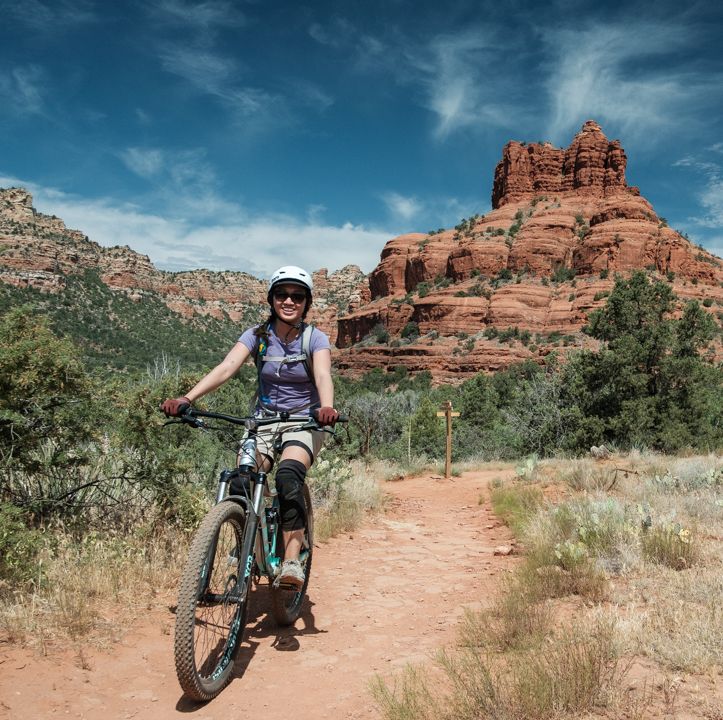
There’s no set mold for what a cyclist looks like–if you ride, you belong. From pavement to gravel to rail trails and singletrack, if you pedal any type of bicycling–with hands or feet, three or two wheels, electric assistance or not–you are a cyclist. These riders verify that fact.
Bicycling | December 2021
Read the full story on bicycling.com and below:
There’s No Set Mold for What a Cyclist Looks Like—If You Ride, You Belong
FROM PAVEMENT AND GRAVEL TO RAIL TRAILS AND SINGLETRACK, IF YOU PEDAL ANY TYPE OF BICYCLE—WITH HANDS OR FEET, THREE OR TWO WHEELS, ELECTRIC ASSISTANCE OR NOT—YOU ARE A CYCLIST. THESE RIDERS VERIFY THAT FACT.
BY MORGAN TILTON
Image: Ryan Duclos, ryanduclos.com
What do you envision when you hear someone identify as a cyclist?
Endless variations of people-on-wheels exist today—there’s no single look or experience level or requirement for how cyclists enjoy cycling.
Bikers roll along roads casually or in race gear; they climb singletrack through the mountains; they load bags onto their frame for multi-day bikepacking adventuresor races. Electronic bikes, tricycles, and handcycles allow bikers to enjoy more miles on wheels and without pain. For some, these designs enable them to continue to participate or get into the sport after a life-altering injury.
One common thread that seems to exist across cyclists of all types, skills, and ability levels—besides that deep love for the sport—is facing moments of self-doubt, imposter syndrome, or disempowering beliefs about one’s capability or place in cycling. It’s a mental barrier, often brought on by a perspective that biking requires specific gear, body types, identities, or routines to be a biker.
If you feel this way, we have a solution to help you escape that headspace: proof in the people who take to the streets or trails on two wheels. Whether you’re a newbie, dabbler, or competitor, and whether you cycle once a day or once a year, if you enjoy getting on your wheels, you are indeed a biker.
Let these people—who overcame their own mental barriers to belonging in the cycling world—show you the way to owning your sport.
Mental Barrier: “I’m larger-bodied and don’t fit in.”
Marley Blonsky, 35, Seattle, Washington
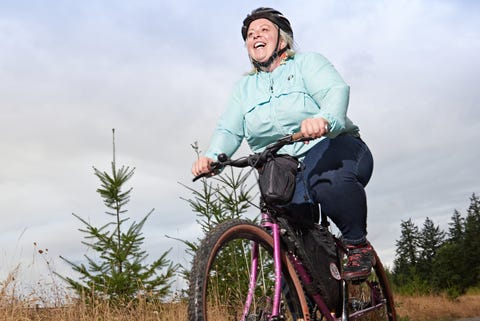
Image: Fontaine Rittleman
For the past eight years, adventure cyclist and sustainability director Marley Blonsky has wholly integrated two wheels into her life. She bikepacks, rides gravel, hauls her pup and groceries with a cargo bike, and dabbles in mountain biking. She loves endurance rides like hosting bikepacking overnighters on Oregon’s Deschutes River Trail or riding the Steamboat Gravel event. Even with all that experience, she never felt like she belonged.
“I’m a larger-bodied person. On group rides, I have been slower and dropped. I felt left out of apparel talk due to sizing—I identify as a fat woman, and I need to wear whatever is functional for me like jeans or a dress,” says Blonsky, who recently co-founded All Bodies on Bikes to change the perception of who rides.
Recently, she pulled on a pair of bibs that fit and a switch flipped. “Pearl Izumi started making 2XL and 3XL clothing sizes—it’s revolutionary,” Blonsky says. That simple adjustment in inclusive sizing gave her the drive to start cyclocross racing.
“I’ve always cheered for friends. Now, I’m confident [enough to go for it]. I’ll be last, but I’m still going to do the race. I still feel like an imposter, because there are hills that people zoom by me on—but I am not letting fear hold me back,” she says. “I shut down the negative internal voices in my head with positive thoughts: If others see me out here, they might see themselves.”
Mental Barrier: “The physical exertion seems daunting alongside a full-time job.”
Scott Brasel, 26, Batavia, Illinois
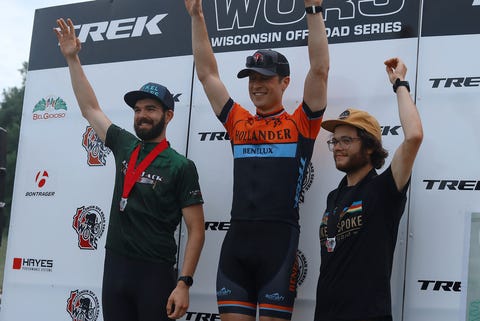
Image: Scott Brasel
Today, Scott Brasel is a cross-country and cyclocross racer in Illinois and Wisconsin. Just three years ago, he was 70 pounds heavier, full of self-doubt, and uncertain about entering the race scene.
“I was intimidated by the idea of a racer status and by the professionals who get paid to race. I was out of shape and thought, ‘Only really athletic people do this.’ I thought, ‘Will I get laughed at, because I’m last and the heavy kid?’” says Brasel, the regional team lead for an IT staffing and recruitment company.
For two years, Brasel’s good friend Jacob Peterson encouraged him to try racing. “I watched Jake compete at races, and there’s a brotherly competition. Eventually, I wanted to prove to him that I could do this, too,” Brasel says.
Racing, training, and cycling balances the stress of a full-time job.
So, he accepted Peterson’s coaching and signed up for his inaugural race in 2018. That’s when something unexpected happened: “The community and working with my coach became the best support system I’ve had ever. It’s a constant collective of community and supportive individuals even during a global pandemic,” Brasel says.
After three years of competing, Brasel stood on the podium at the Iola Bump and Jump, a mountain bike race in Wisconsin. He followed that up with a top-three placement at nearly every race he finished this year (nine podium finishes out of 13 races).
“I love that you can work a full-time job, train 10 to 15 hours a week, and compete in cycling alongside professionals,” Brasel says. “As a whole, racing, training, and cycling balances the stress of a full-time job. It’s an outlet for all the anxieties and heartache through the day and year.”
Mental Barrier: “Riding is fitness-focused and requires fancy gear.”
Nicki Bruckmann, 39, Cincinatti, Ohio
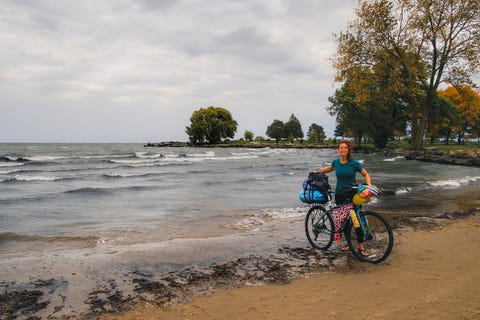
Image: Nicki Bruckmann
When Nicki Bruckmann’s former life partner introduced her to biking, she recalls that the road bike he gifted her was $800—a moment in which she realized the financial cost of cycling and began to think that in order to ride, you needed top-level gear.
“I was led to believe I could only wear padded shorts, clip-in shoes, and jerseys. I was surrounded by wealthy riders with all the proper apparel,” says Bruckmann.
Eventually, she started to feel like the investment in registering for races also wasn’t sustainable, and the event and race scene remained intimidating. So, Bruckmann ditched her bike gear and took a multi-year hiatus from riding altogether.
Following a foot injury in 2015, a friend told her to ride her bike for her health using sneakers, flat pedals, and gym clothes—a fresh perspective that got her back into the sport. “I learned that biking can be fun. I started riding rail trails with friends connecting breweries around the city, riding as fast as the slowest person and stopping along the way,” says Bruckmann.
Now, Bruckmann is the founder of Explorer Chick, an adventure travel tour company for women which she launched in 2014, after getting back into cycling.
Last year, Bruckman started lightweight bike touring, too. She completed a five-day, 324-mile ride across the state with two nights in a tent, three in hotels, and “glittery, leopard-print bikepacking bags” she found on Etsy.
She says, “Don’t let complicated goals keep you from biking—it’s important to just go out and ride your bike.” And forget about the requirement for fancy gear, too. All you need is two wheels, comfy clothes, and the motivation to log some miles.
Mental Barrier: “I’m not experienced in this discipline and I don’t belong.”
Quincy Cowherd, 24, Los Angeles

Image: Quincy Cowherd
Not long after learning how to walk, Los Angeles local, Quincy Cowherd pedaled his first mountain bike, alongside his dad in a city park, when he was just 4 years old. As a teenager, the African American and Ghanaian rider explored the surrounding urban landscape on a fixie with friends.
But when Cowherd’s bike was stolen, he didn’t ride for a handful of years. That is, until the pandemic, when he decided to build a single-speed mountain bike to explore the trail network around his childhood city, which he stills calls home.
Around that time, Cowherd caught wind of the Ride for Racial Justice athlete application to remotely train for and ride the annual 2021 SBT GRVL event in Steamboat Springs, Colorado, with a 25-person BIPOC (Black, Indigenous, People of Color) crew from across the country.
That’s what you need when you start cycling, people who encourage you.
“I’d never heard of gravel riding, and it opened my eyes to a whole new side of cycling—getting chosen to join the group was a miracle. I was so excited,” says Cowherd, who anxiously jumped into a local road cycling meet-up to start training for the endurance ride.
“Everyone had slick wheels, nice helmets, and carbon fiber frames, and all I had was a mountain bike with gears. They really made me feel like I belonged, though, which I was not expecting,” he says. “During the ride, they congratulated me, said I was doing really well, and made me feel good about myself. There are LA ride groups that will drop newcomers—I got lucky.” That’s what you need when you start cycling, he says, people who encourage you and give positive reinforcement, so you feel like you belong.
Closer to the gravel event, Cowherd says he questioned his place in the discipline. But when he met his fellow BIPOC teammates in Steamboat Springs, the narrative flipped. “They gave so many words of encouragement, it was a family-like atmosphere when I first met them and I definitely belonged,” he says.
Now, Cowherd volunteers with the Mountain Bike Unit, a team that patrols the Santa Monica Mountains by bike. “They offer first aid on trails and bring bikes to inner-city kids to take them to mountains and show them a whole new world they never thought existed. I want to help open the door for kids and make cycling more inclusive in my community,” he says.
Mental Barrier: “At this age—and at high altitude—I can’t learn to mountain bike.”
Wendy Deacon, 54, Denver, Colorado
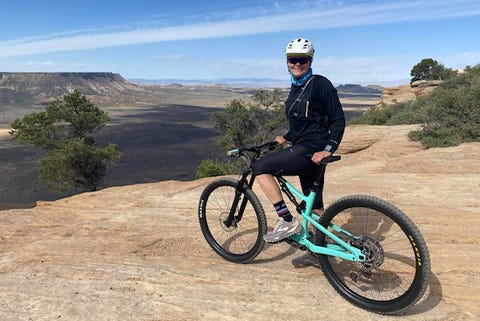
Image: Wendy Deacon
At age 46, Wendy Deacon moved from Texas to Colorado’s high-altitude and was sucking wind on her bike. She felt slow. She was also going through a huge life transition following a divorce, and knew she had to build a new community that also valued healthy routines. She struck out finding her circle at the bars on Saturday nights.
These friendships from cycling changed the quality of my life.
The founder of DestinationU, an active lifestyle organization that brings together women over age 40, Deacon researched club and race teams online, inquired about no-drop rides, and interviewed the organizers about the availability of mentors. “It takes work to find a new community and friends—I had to be proactive,” she says.
After six months of riding with a mellow road cycling meet-up, her body adjusted to the altitude. Witnessing her body’s ability to adapt and become stronger in a new environment and in her late 40s made her feel reconnected to herself and to the joy of the sport.
So, she decided to challenge herself and find a new crew that could help support her new aspirations: races and learning how to mountain bike. “There are chapters of your life and riding partners can come in and out, too—and that’s OK,” says Deacon, also a member of Physio Racing, a team of cyclists of all ages and skill levels pursuing road and off-trail goals. “These friendships from cycling changed the quality of my life,” she says. It’s that community that helps you feel like you belong and keeps you riding through life’s challenges.
Mental Barrier: “I don’t see anyone who looks or acts like me on a mountain bike and the trails.”
Patricia Nguyễn, 39, South California

Image: Ryan Duclos, ryanduclos.com
Patricia Nguyễn’s debut two-wheeler was a fixie she rode to lower her carbon footprint, after returning home from a trip to Vietnam where she witnessed that biking is endemic to her Asian culture. Free of gears, the setup was the simplest, cheapest option.
“I saw people who looked like me with their fixies riding on the beach or on public transportation, which was empowering,” she says. “It felt aligned with who I was, and it had a strong community. There are famous, badass Asian fixie riders that are inspiring to watch. And representation matters.”
Nguyễn has worked for more than a decade in diversity leadership roles including serving as a board member of Women’s Wilderness. “I’m the daughter of refugee parents, identify as queer, and I’m racially Asian American. I don’t know anyone in my social networks, family, or even people who look like me who mountain bike,” says Nguyễn. But after buying a mountain bike a few years ago, she still hits the trails, sharing the hobby with her partner.
One of Nguyễn’s first rides was the Whole Enchilada in Moab, Utah, which was demoralizing due to the trail’s difficulty, she says. But rather than deriving her self-worth from covering every mile, she realized it was perfectly acceptable to not finish a trail when she felt uncomfortable and return another time. So she went home and did smaller rides several times a week with her partner to build her skills.
“This year we went back. I saw how I improved and rode a greater portion of the route: Re-riding trails and working on skillsets is important. After that ride, I felt so good, I also learned how to wheelie, which has helped me climb better,” says Nguyễn.
From her experience at Moab, Nguyễn learned that a shift in mentality helps keep you moving forward in cycling. “Now, I focus on the process versus product, removing the colonizing lens of summitting, knowing it’s OK to not finish a route,” she says. “With that mindset, everything clicks and my confidence builds.”
Mental Barrier: “My gender and sexual orientation will not be accepted.”
Alex Showerman, 33, RV-nomad across North America
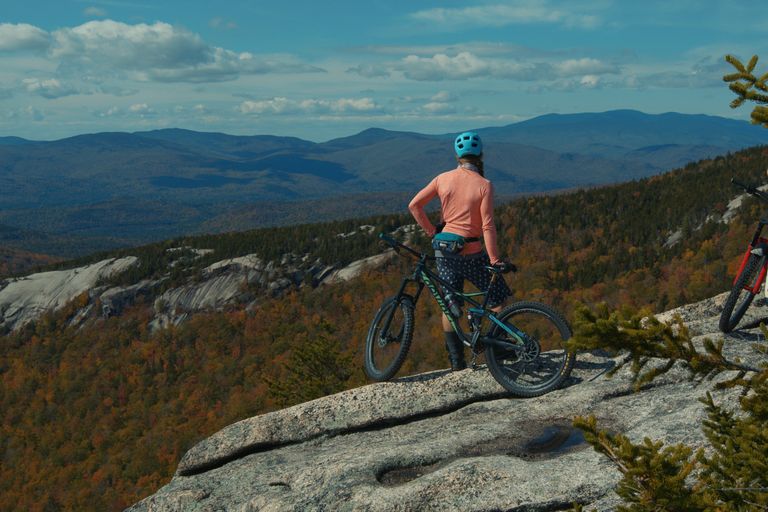
Image: Adam Lukowski
Alex Showerman has participated in mountain biking, BMX, and trail advocacy since her childhood days in Vermont. And while every time she went to bike parks, she deeply loved the gravity component, she also felt uncomfortable. “There was a cool kid, bro attitude that didn’t feel welcoming or safe,” says Showerman, a queer transgender woman. “Being closeted, it felt like there was no way these people would accept me.”
Then Red Bull launched the first-ever freeride camp for women in 2019, called Red Bull Formation. Inspired by the iconic 12-year-old Red Bull Rampage event in Virgin, Utah—an event in which female riders had never qualified to participate—this new approach invited woman to collaboratively build lines in the steep canyons and uplift each other.
After the second five-day Formation took place this year, a “tidal wave of progression followed for women at bike parks and with more all-women events,” says Showerman, who continued to cheer on the event.
Then, this summer, Showerman was invited to participate in a separate, also empowering virtual progression program hosted by Red Bull.
“Getting that intentional invite was the first time I felt seen and valid in the space,” Showerman says. “I hope by me being visible that invite gets extended to more queer and trans women. Once I was welcomed in, I got way better as a biker too. And I strive to create space for LGBTQ+ folks and anyone who identifies as a woman to know they belong in action sports and to use action sports as a tool to create a more empathetic and inclusive world.”
Mental Barrier: “I can’t find an inclusive bike shop or local ride group.”
Liz Villarreal, 41, Portland, Oregon
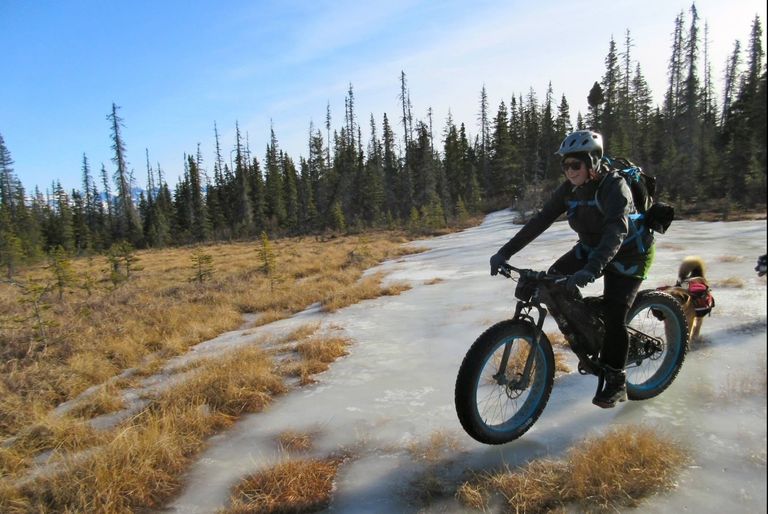
Image: Liz Villarreal
Liz Villarreal is a mixed native Chicana with Mohawk, Métis, Irish, and French lineage—and her identity as a biker has been a rollercoaster the past few decades.
In middle school, her parents put an end to Villarreal commuting to class via her beloved banana-seat lowrider, due to an increase of gang violence and drive-by shootings in the Los Angeles area. Her relocation to Santa Cruz, California for college landed her in a mountain bike haven. “But the thick bro culture made mountain biking feel so elitist and hardcore—it’s really hard to break into,” she says. “Every couple years in Santa Cruz, I’d muster the confidence to ride, only to be told I wasn’t skilled enough. I’ve since had the same experience while riding trails in Hood River.”
I ride a bike that goes nowhere all the time and love it.
Post college, Villarreal lived in Alaska for 15 years, where she became friends with the owner of Cycle Logical, a Homer-based bike shop. Unable to afford her own, she borrowed bikes and got plugged into a welcoming circle of riders that she joined for a fat-tire bikepacking trip across an ice-patched tundra to a cabin adjacent to Caribou Lake. “That trip was so good for my psyche. I felt the best I ever have on a bike,” she says, adding that the region’s remoteness and limited resources made the community feel more inviting to newcomers. “If it’s a small enough community, you have to depend on each other,” she says.
Now, after living in Portland for five years, Villarreal still struggles to find a welcoming bike shop, riders that look like her, inclusive sized apparel, and an affordable mountain bike—which in part catalyzed her to become a devout four-times-a-week Peloton cyclist. And she feels like she found her community again, even if it’s a little different than groups past.
“I ride a bike that goes nowhere all the time and love it,” she says. “The virtual rides are super welcoming, and you feel like you have your pack. Regardless of scheduling conflicts with my mountain bike allies, I can ride. Through the online Peloton forums, I’ve made friends all over the world. The Peloton brought me back to life.”

